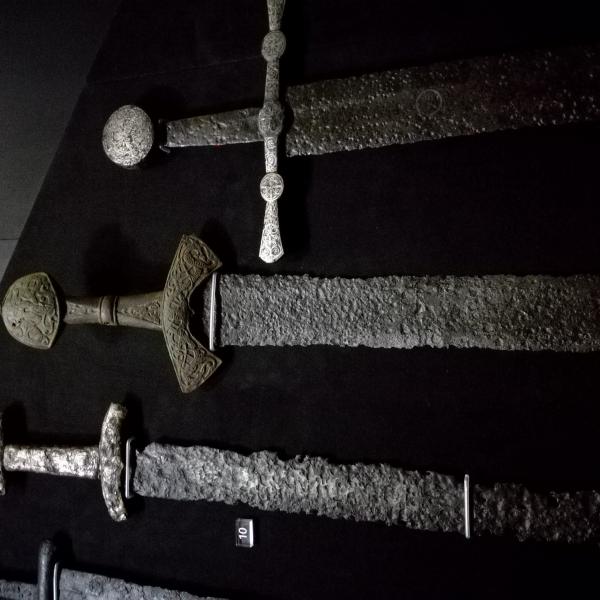Laura Miller and Rebecca Copeland, coeditors of Diva Nation: Female Icons from Japanese Cultural History, discuss queens, goddesses, and the nature of "diva-hood."
Transcript:
Claire Gauen (host): Thanks for listening to Hold That Thought. I'm Claire Gauen. Today I am delighted to be sitting down with Rebecca Copeland, who is a professor of Japanese language and literature here at Washington University in St. Louis. We are also accompanied by Laura Miller, endowed professor of Japanese studies and professor of history at the University of Missouri St. Louis. Thank you so much for joining us.

Rebecca Copeland: Thank you for having us.
Laura Miller: Thank you.
CG: So the reason that we invited you in today is to talk about your coedited volume that was published earlier this year with a title that I think is pretty fabulous. It's called Diva Nation: Female Icons from Japanese Cultural History. This book has a great title, and it also has a great opening line. It says: "We did not go searching for her, this diva from Japan. She was already there." I just love that line. Can you elaborate? Where and how did you find this diva from Japan?
LM: The divas we included were never hidden or obscured or anything, so finding them was easy. There are other divas that we could have included. So the choice of who we included depended on the contributors and what their particular interests were. But mainly these were figures that lodged in our consciousness because of something about them and something about the standard depictions of them that we thought fell short. So, for example, one of the contributors - Carolyn Stephens - has a book that just came out on the Beatles in Japan. And of course she had to talk about Yoko Ono, but she wanted to look at Yoko Ono not as the woman who wrecked the Beatles but as an artist in her own right.
In my case, I got interested in the third-century shaman ruler named Himiko through some other research. In the course of that research, she kept popping up. I couldn't avoid her. I'm actually trained as an anthropologist, and I was doing research on tarot cards in Japan and the people who read tarot cards. I found a place where a specialist was offering tarot readings using a special French deck. She advertised that she had met and trained with a French master. So I thought, oh I have to go interview her! So I went to her place of business, which was a kind of sketchy building in Shibuya, in Tokyo. She met me at the door, and she was accompanied by her office-mate, who was a woman clothed in these white robes who said she channeled Himiko and was pulling on the original divination used by Japanese women. I was just so enchanted by this. And I thought, "Why is a contemporary business woman in the divination industry wanting to to tie this ancient sovereign to her business?" I thought that was really interesting. And then I kept finding and stumbling across other women in the divination industry who were also using Himiko as some sort of tie in. So, I got interested in this figure because of these contemporary eruptions of her.
RC: I think when we tell people that we wrote about "Diva Nation" they immediately assume something about diva, right? They think, "oh, well, you must mean an opera star," or maybe they think, "you must mean a nasty television personality." And there are those kinds of people in Japan. We could have selected amazing opera stars and turned them into the subject of our book, or TV personalities. But that's not really what we were going after with the idea of diva. We were more interested in unruly, insistent women (or female-identified individuals because not all of our divas are biological females). So we were interested in these naughty women who inhabit Japanese history and myth but are often overlooked or just a side note in Japanese mainstream historical accounts. We were wondering why aren't they the story instead of just the side note. I think a lot of our chapters are recovering - I guess recovering isn't the right word because they were never hidden - but pulling into the spotlight these incredible, unruly, insistent, daring characters from Japanese myth and history.
CG: I'm glad you brought that up. It's interesting that the word diva carries such weight. I feel like it means a lot of different things to different people. In addition to their unruliness, is there anything that brings these divas together?
RC: Well I think a lot of them question Japanese social stereotypes, or just stereotypes in general, about what a woman is allowed to do. Many of the individuals that we were dealing with are women who crossed borders, who transgressed and were either reviled for it or celebrated. And that's what drew them to us or how they entered our lives, I guess. It's because they were crossing so many borders.
"Many of the individuals that we were dealing with are women who crossed borders, who transgressed, and were either reviled for it or celebrated."
CG: So the diva that you focused on in the book is Izanami, a goddess. Can you tell us about her?
RC: She is the founding goddess of Japan. She and her male partner were the creators of the Japanese archipelago and the Japanese world. I guess you could kind of compare her to Eve, so the Japanese Eve. They gave birth to all of the nature and rocks and sea and everything that created the Japanese world. But Izanami died giving birth to fire. She was mortally wounded, and so she ended up in the underworld. Her male partner was distraught by her absence, and in a fit of desire chased after her only to discover her decaying corpse. He was disgusted by that, and of course he fled.
Right before he went and found her, she had said to not look in her room. So of course, what did he do? He goes and he looks, and he sees her rotting corpse, and he runs away - and then he throws this huge boulder that sealed her in her place in this underworld. After he seals her in her place, she says, "How dare you! You have broken your troth to me, and you've looked when I told you not to. I'm going to kill a thousand people in your world every day." And he said, "Okay, then I'm going to build a 1,500 birthing huts every day." So that tells us how life and death were created, and so forth.
That's really where the myths stop. We're left with Izanami in the dark cave. That's the end of her story. So the contemporary Japanese author Kirino Natsuo comes and picks up where that story left off. What's Izanami thinking? How was she operating her day-to-day killing of all these people? The story tells us what happens next. And in that story Izanami is rightfully outraged, but she is taking her duties of killing very seriously and acquitting herself with great dignity and divahood. So that was my contribution.
CG: That's an interesting take. I feel like just hearing the story itself, it seems that this goddess is locked away and she's stripped of her power, or seemingly so. Showing how that potentially was not true is an interesting take on how to tell a diva story.
RC: Well the author Kirino Natsuo is a living author, a contemporary author, who is known for her darkly disturbing psychological studies of human nature and of Japanese society. She particularly focuses on the inequity of the gendered structure in Japanese society. So she was really interested in why is it that women are the ones who are tied to biological function. Why are the female of the species the ones who are always marked as defiled? She's really interrogating that question in this novel that my chapter is based on and showing that this is a complete construction, right? It's a social construction, and Izanami in her dark lair is interestingly shining a light on the myth of female defilement. In that sense, both she and her author are very much divas.
CG: Absolutely. Another diva discussed in the book, in your chapter, Dr. Miller, is an actual historical figure if I understand correctly, though there might be some mythical components - Queen Himiko. You talked about how you found her, but can you tell us a bit of her story?
LM: Sure. The Chinese court was interested in the outlying countries and cultures around them and sent ethnohistorians around to look at the neighboring peoples. They described a state what is now Japan, and they were really surprised to find that it was ruled by a woman named Himiko. So she's actually interesting for a number of reasons. She's the first Japanese person whose name is in any recorded history, so that's something to keep in mind. They described her as the paramount chief of a confederation of small chiefdoms. She ruled for a long time, from the time she was a young woman to when she died from 190 CE to 248, and she never married. They thought that was interesting. They also commented that she ruled by means of magic, that she was a kind of shaman priestess, and that when she died she was buried in this lavish earth tomb.
These tantalizing details have really created a lot of debate and speculation among Japanese historians. For centuries, especially the location of her realm, which was called Yamatai. I think today, scholars are coming around to the idea that she is buried in Sakurai city, which is an Nara prefecture, in a tomb called Hashihaka Kofun, or chopsticks tomb. So she's an interesting figure for all of these reasons, but what I found was that contemporary people are having a lot of fun using her image for all sorts of reasons.
CG: You mentioned the tarot card reader channeling Himiko, but you found all sorts of other contemporary instances where she's brought up in unexpected ways. What were some of the places that you found her?
LM: She's really commodified and exploited in some of these local towns in Nara and in Shiga prefecture for the townspeople to claim some kind of ancient continuity, so real Japanese-ness. So they use her as a mascot. The city of Sakurai where the tomb is created a very cute manga-like mascot named Himiko-chan. And so Himiko-chan is on all sorts of goods and on official posters and so on. These towns have created Himiko-themed beauty contests and other kind of touristic things. So she's just really accessible as a symbol of ancient Japan that people are exploiting right now.
CG: Do you think that reveals anything about Japanese culture today? In the story you told at the beginning, she seems this powerful, mystical being. Then she's transformed into this mascot that's kind of cute. It's not necessarily a negative image, but also maybe not what you would expect.
LM: I would say that the different representations or uses or interpretations of Himiko really vary greatly around Japan and in different media. It depends on the creator or the user's purpose. So, as you mentioned, a lot of it is ignoring or not really wanting to deal with her status as an authority figure and instead using her as simply a cute figure from the past. It depends on the context, but she allows that. Her diva-hood means that she can be used in all sorts of ways.
RC: So that's kind of the second half of our title - nation. All of these divas tell us about Japanese national identity or how Japan positions itself as a society, as a nation. So you have Himiko, and Izanami as well, as sort of the foundational forces behind the development of the Japanese nation, but they also represent the anxieties about change of national identity - and gender in that identity. Every diva that we deal with has something to tell us about Japan as a world order.
"Every diva that we deal with has something to tell us about Japan as a world order."
LM: You know, I would say that all of the divas in the volume are problematic in some way because, as Rebecca mentioned, they don't conform very well to expected gender roles, and historians either downplay that or ignore it. So they must mention these divas - all these divas are integral to any historical overview of Japanese society or music or popular culture. Writers, when they find these problematic aspects of the diva, they just underplay them. That's what drew us to them, also. We wanted to expand and explore what these problematic aspects of the divas.
CG: Were there any parts of these stories, or perhaps a certain character - either in the chapters you worked on or the pieces that you read from other contributors - that that really stood out or really surprised you?
RC: I think Laura has already mentioned this in a way, but the fact that there's such continuity regardless of how old the diva is or whenever the diva appeared in history - we still see them, and they still keep coming up. There's one diva who did a kind of erotic dance in front of a cave to lure the sun goddess out. This was another mythic story, but that kind of power and eroticism, and the way that it has been used over time to to disrupt, is something that continues throughout Japanese history - or any history, I suppose. Up into the very contemporary period we have the vagina artist, who has also exposed herself to public scrutiny to be disruptive and has met with a different kind of reception. There's just so much continuity. Everything changes but everything stays the same in a lot of our stories.
LM: I was impressed - not surprised necessarily, but impressed - by how all the contributors were able to really pull out details and were so meticulous in their research and explored ideas that were often just left out of the story. For example, our colleague Jan Bardsley wrote a chapter on Iko, a beauty expert who I didn't know before her chapter was actually involved in the tourism industry to Korea because of her own personal background. I think that was the nice part about the project.
RC: We found that all of these divas sort of shared a similar sense of discovery, of crossing borders, but also having been wounded. They've all been somehow troubled by a society that has rejected them or despises them. Yoko Ono has confronted all kinds of rejection on both sides of the Pacific, and that's just very typical of the divas that we encountered. It's some how through their suffering that they emerge as these very dynamic and daring figures.
CG: Has your examinations of these historical divas perhaps made you think differently about female icons today, or contemporary figures of diva-hood?
LM: Not so much that, but I think looking at divas from history and how people today are reclaiming them in various ways, and using their representations in various ways, really was interesting to see. There's this range of responses and interpretations, especially manga artists and people in literature and film, exploit the divas from history for all sorts of purposes. That was one way that I think attention to divas changes how we think about female roles.
RC: We look at the past and we think they had it so bad. It was so difficult. There was so much they had to resist and overcome. And in that sense, it was easy for them to be divas. Whereas nowadays, when things are much more open, how do we do the same things that these divas of the past did? How do we perform on the edge the way that they did? I think what we discovered is that there is the potential for diva-hood in all of us, and that regardless of how wide we may think the system is, somebody is being restricted somewhere, and there's a role for us to all play in trying to make the playing field more open and even.
CG: That's a great point and a great takeaway. So, obviously we hope everyone who listens to this runs out and buys a copy of Diva Nation, but if people instead are inspired to perhaps go to Google - is there any one figure or story that you think people should look up first?
LM: Obviously I'd say Himiko is a good place to start. Definitely.
RC: But the thing is, if we start with Himiko, for example, if we say Himiko is that essential - if you start with her, she'll lead you to the next one. It's like potato chips; you can't just have one.
CG: To all of our listeners, thank you so much for tuning in. Thank you to Dr. Copeland and Dr. Miller for joining us today. Their coedited book, once again, is Diva Nation.




